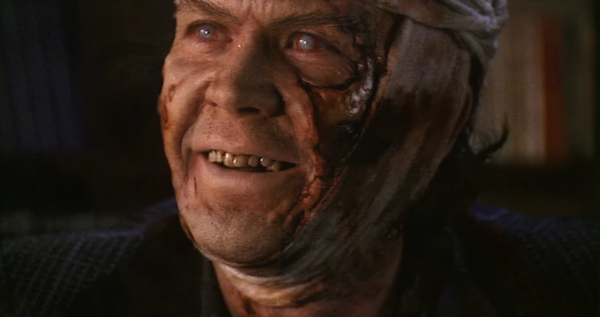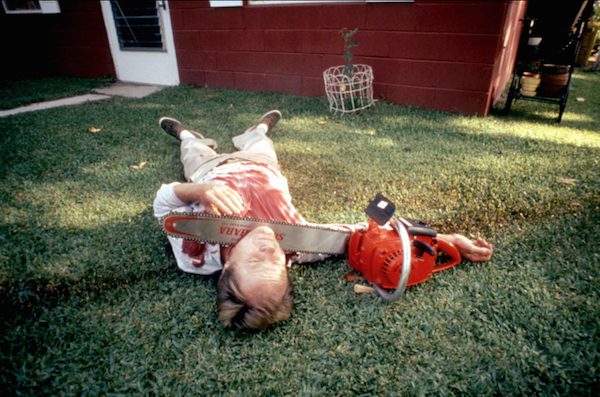Table of contents
1. Graveyard Shift (1990)

Assistant director of plenty of classic 70s films (Taxi Driver, Network, Three Days of the Condor) Ralph S. Singleton gets a promotion or maybe it’s a demotion to director of Graveyard Shift – his first and last director gig.
The plot involves our drifter hero taking a job in a cotton mill, where the worker conditions range from grotesque to lethal – topped off with a giant rat/bat monster on the loose. Workers also have to endure the psychotic asshole foreman Warwick, (played by a scenery-chewing Stephen Macht), who is more monstrous than the monster.
In what must be the weakest worker’s union ever, these poor wage slaves must endure verbal and physical abuse, high job turnover resulting from a gruesome death, rats everywhere, extreme heat, filth, and probably every labor rights violation put into law. There’s no mistaking Graveyard Shift for anything other than trash, but it’s enjoyable trash.
Paramount tossed the movie into the Halloween marketplace in 1990 and the only other competition was from the dud remake of Night Of The Living Dead which was released one week prior. Graveyard Shift was not screened in advance for critics, was given a lousy C- cinemascore from audiences and it quickly left theaters with $11,582,891 at the box office. The Stephen King brand got a critical and box office boost just one month later when Misery was released.
2. The Dark Half (1993)

Horror vet George A. Romero’s big-screen adaptation of King’s novel was beset by distribution woes and an unpleasant production stemming from studio interference, a difficult lead actor and a cinematographer who was less than collaborative. Romero said of the production:
I had such a bad experience with [The Dark Half]. Orion was supposed to be the filmmaker’s studio, but I had bigger trouble with them than Universal. I was terrified of Universal! [But Orion was] really terrible to work for. It was really tough… With The Dark Half, I had a DP who thought he was going to win an Oscar, and just gave me grief every minute. He quit indignantly about six times, and I thought I was gonna get canned because of my problems with Tim Hutton. I was ready to just throw my hands up, it was really hard to keep a rope on that one. But that’s what happens.
George A. Romero
The Dark Half completed filming in early 1991, but the release was delayed indefinitely, when the distributor Orion filed for Chapter 11 in December 1991. Eventually, Orion was able to raise $73 million for prints & advertising for the slate of movies that were collecting dust in a vault and each picture roughly received $10 million.
The Dark Half was finally released on April 23, 1993, and received a muted response from critics. It quickly bombed out of theaters with just $10,611,160. Out of the entire slate of delayed Orion movies, the terrible box office numbers from The Dark Half and RoboCop 3 (also $10.6 million) were the top two performers.
After The Dark Half came and went, Romero was not able to get another movie off the ground until he made the low-budget Bruiser in 2000. Four months after The Dark Half opened, the King adaptation Needful Things flopped.
3. Needful Things (1993)

Let’s have Ed Harris do the talking here:
I did some really bad films in there too, man, I did Needful Things and Milk Money… I joined CAA in 1990 and they were asking me if I wanted to do things like “Milk Money” and “Needful Things”, and they were paying me more money than I had made and giving me a chance to do a comedy. I justified the films in some way, but they were really bad. I try to be a little bit more careful now.
Ed Harris
Critics hated the film as much as the lead actor and Columbia dated this King adaptation at the slow end of summer marketplace.
Needful Things opened with a soft $5,202,478 and quickly sputtered out of release with $15,185,672.
4. Thinner (1996)

Tom Holland’s last big-screen film, in which he states that the studio gutted the dark humor and changed his warped ending after test screenings, but what’s left is a playful enough horror entry.
Robert John Burke chews the scenery but brings some much-needed energy to this film as an unscrupulous obese lawyer who starts wasting away from a gypsy curse. It’s a makeup fx heavy film and some of the lighting in the film works against the makeup, especially the fat suit – which isn’t very convincing. The skinny effects are more effective and the makeup on Michael Constantine as the elder Lempke is top-notch.
Budgeted at $17 million, Paramount didn’t bother the screen the movie for critics and dated it for the 1996 Halloween frame on October 25. Thinner pulled in an underwhelming $5,679,046 and quickly left theaters with $15,315,484.
5. Maximum Overdrive (1986)

Written and directed by the man himself, let’s let Stephen King’s words describe Maximum Overdrive.
This is a moron movie, like Splash! You check your brains at the box office and you come out 96 minutes later and pick them up again. People say, ‘How’d you like the movie,’ and you can’t say much. It’s not like The Big Chill or 2001… The problem with [Maximum Overdrive] is that I was coked out of my mind all through its production, and I didn’t know what I was doing.
Stephen King
Maximum Overdrive was released on July 25, 1986, and along with lousy reviews, it had the misfortune of opening just one week after Aliens.
Paying audiences hated the movie as much as its creator and gave it a D+ cinemascore and the pic bombed out of theaters quickly with $7,433,663.
6. Dreamcatcher (2003)

Dreamcatcher is a one-of-a-kind mess, a film so disjointed and bizarre that for all of its problems, you can never fault it for being predictable. A handful of childhood friends who have some psychic abilities, meet annually in a remote snowbound cabin to unwind and drink. That is interrupted by infected people passing gas and having parasitic aliens burst out of their anus.
William Goldman, the man who wrote All the President’s Men, and Lawrence Kasdan who made the Big Chill and co-wrote The Empire Strikes Back and Raiders of the Lost Ark – combine their talents to a first act dedicated to scatological humor, then scatological horror and basically all things gas and poo. There’s no rational justification for the mess the filmmakers made and trust me when you see the bathroom set piece covered in blood and shit, it’s a serious mess.
Alien ‘shit-weasels’ that burrow out of people’s assholes, somehow justified a $68 million budget courtesy of Warner Bros, Castle Rock, and Village Roadshow.
Along with terrible reviews, adding to Dreamcatcher’s troubles was the Iraq invasion, which began the day prior to its release, and news coverage of the war kept many auds at home. Those that showed up gave it a poor C+ cinemascore and it bombed out of theaters with $33,715,436.
Veteran director Lawrence Kasdan found himself out of work after Dreamcatcher for 9 years and finally directed the low-budget Darling Companion outside of the studio system.


